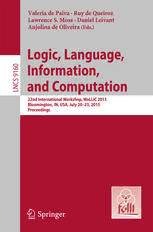
Logic, Language, Information, and Computation: 22nd International Workshop, WoLLIC 2015, Bloomington, IN, USA, July 20-23, 2015, Proceedings PDF
Preview Logic, Language, Information, and Computation: 22nd International Workshop, WoLLIC 2015, Bloomington, IN, USA, July 20-23, 2015, Proceedings
Valeria de Paiva · Ruy de Queiroz Lawrence S. Moss · Daniel Leivant Anjolina de Oliveira (Eds.) Logic, Language, 0 Information, 6 1 9 S and Computation C N L 22nd International Workshop, WoLLIC 2015 Bloomington, IN, USA, July 20–23, 2015 Proceedings 123 Lecture Notes in Computer Science 9160 CommencedPublicationin1973 FoundingandFormerSeriesEditors: GerhardGoos,JurisHartmanis,andJanvanLeeuwen EditorialBoard DavidHutchison,UK TakeoKanade,USA JosefKittler,UK JonM.Kleinberg,USA FriedemannMattern,Switzerland JohnC.Mitchell,USA MoniNaor,Israel C.PanduRangan,India BernhardSteffen,Germany DemetriTerzopoulos,USA DougTygar,USA GerhardWeikum,Germany FoLLI Publications on Logic, Language and Information SublineofLectures NotesinComputerScience SublineEditors-in-Chief ValentinGoranko,TechnicalUniversity,Lynbgy,Denmark MichaelMoortgat,UtrechtUniversity,TheNetherlands SublineAreaEditors NickBezhanishvili,UtrechtUniversity,TheNetherlands AnujDawar,UniversityofCambridge,UK PhilippedeGroote,Inria-Lorraine,Nancy,France GerhardJäger,UniversityofTübingen,Germany FenrongLiu,TsinghuaUniversity,Beijing,China EricPacuit,UniversityofMaryland,USA RuydeQueiroz,UniversidadeFederaldePernambuco,Brazil RamRamanujam,InstituteofMathematicalSciences,Chennai,India More information about this series at http://www.springer.com/series/7407 Valeria de Paiva Ruy de Queiroz (cid:129) Lawrence S. Moss Daniel Leivant (cid:129) Anjolina G. de Oliveira (Eds.) Logic, Language, Information, and Computation 22nd International Workshop, WoLLIC 2015 – Bloomington, IN, USA, July 20 23, 2015 Proceedings 123 Editors Valeria dePaiva DanielLeivant Nuance Communications Department ofComputer Science Sunnyvale,CA Indiana University Bloomington USA Bloomington,IN USA RuydeQueiroz CentrodeInformática Anjolina G.deOliveira Universidade FederaldePernambuco CentrodeInformática Recife, PE Universidade FederaldePernambuco Brazil Recife, PE Brazil Lawrence S.Moss Department ofMathematics Indiana University Bloomington Bloomington,IN USA ISSN 0302-9743 ISSN 1611-3349 (electronic) Lecture Notesin Computer Science ISBN 978-3-662-47708-3 ISBN978-3-662-47709-0 (eBook) DOI 10.1007/978-3-662-47709-0 LibraryofCongressControlNumber:2015942533 LNCSSublibrary:SL1–TheoreticalComputerScienceandGeneralIssues SpringerHeidelbergNewYorkDordrechtLondon ©Springer-VerlagBerlinHeidelberg2015 Thisworkissubjecttocopyright.AllrightsarereservedbythePublisher,whetherthewholeorpartofthe material is concerned, specifically the rights of translation, reprinting, reuse of illustrations, recitation, broadcasting, reproduction on microfilms or in any other physical way, and transmission or information storageandretrieval,electronicadaptation,computersoftware,orbysimilarordissimilarmethodologynow knownorhereafterdeveloped. Theuseofgeneraldescriptivenames,registerednames,trademarks,servicemarks,etc.inthispublication doesnotimply,evenintheabsenceofaspecificstatement,thatsuchnamesareexemptfromtherelevant protectivelawsandregulationsandthereforefreeforgeneraluse. Thepublisher,theauthorsandtheeditorsaresafetoassumethattheadviceandinformationinthisbookare believedtobetrueandaccurateatthedateofpublication.Neitherthepublishernortheauthorsortheeditors give a warranty, express or implied, with respect to the material contained herein or for any errors or omissionsthatmayhavebeenmade. Printedonacid-freepaper Springer-VerlagGmbHBerlinHeidelbergispartofSpringerScience+BusinessMedia (www.springer.com) Preface Thisvolumecontainsthepaperspresentedatthe22ndWorkshoponLogic,Language, Information and Computation (WoLLIC 2015) held during July 19–22, 2015, at the Department of Computer Science, Indiana University, Bloomington, Indiana, USA. The WoLLIC series of workshops started in 1994 with the aim of fostering interdis- ciplinary research in pure and applied logic. The idea is to have a forum that is large enoughinthenumberofpossibleinteractionsbetweenlogicandthesciencesrelatedto informationandcomputation,andyetissmallenoughtoallowforconcreteanduseful interaction among participants. There were 44 submissions, and each submission was reviewed by at least three Program Committee members. The committee decided to accept 14 papers. The pro- gram also included eight invited lectures by Adriana Compagnoni (Stevens Institute, USA),NinaGierasimczuk(UniversityofAmsterdam,TheNetherlands),JohnHarrison (Intel, USA), Peter Jipsen (Chapman University, USA), André Joyal (University of Québec Montréal, Canada), Chung-chieh Shan (Indiana University, USA), Alexandra Silva (Radboud University Nijmegen, The Netherlands) and Mehrnoosh Sadrzadeh (QueenMaryUniversityofLondon,UK).TherewerealsofourtutorialsgivenbyNina Gierasimczuk, John Harrison, André Joyal, and Alexandra Silva. In remembrance of the 30th anniversary of the death of Julia Hall Bowman Robinson (December 8, 1919 – July 30, 1985), the American mathematician best known for her work on decision problems, the program of the meeting included a screening of George Csicsery’s documentary “Julia Robinson and Hilbert’s Tenth Problem”(2008).Asatributetoarecentbreakthroughinmathematics,therewasalsoa screening of Csicsery’s “Counting from Infinity: Yitang Zhang and the Twin Prime Conjecture” (2015), which centers on the life and work of Yitang Zhang in the cele- brated Twin Prime Conjecture, the result that there are infinitely pairs of primes sep- arated by at most 70 million. We would very much like to thank all Program Committee members and external reviewersfortheworkthey putintoreviewingthesubmissions. Thehelp providedby theEasyChairsystemcreatedbyAndreiVoronkovisgratefullyacknowledged.Finally, wewouldliketoacknowledgethegenerousfinancialsupportbytheIndianaUniversity School of Informatics and Computing’s Department of Computer Science, and the scientific sponsorship of the following organizations: Interest Group in Pure and Applied Logics (IGPL), The Association for Logic, Language and Information (FoLLI),AssociationforSymbolicLogic(ASL),EuropeanAssociationforTheoretical VI Preface Computer Science (EATCS), European Association for Computer Science Logic (EACSL), Sociedade Brasileira de Computação (SBC), and Sociedade Brasileira de Logica (SBL). May 2015 Valeria de Paiva Ruy de Queiroz Lawrence S. Moss Daniel Leivant Anjolina G. de Oliveira Organization Program Committee Robin Cooper University of Gothenburg, Sweden Gerard de Melo Tsinghua University, China Valeria De Paiva Nuance Communications, USA Catarina Dutlh Novaes University of Groningen, The Netherlands Martin Escardo University of Birmingham, UK Nikolaos Galatos University of Denver, USA Achim Jung University of Birmingham, UK Sara Kalvala University of Warwick, UK Elham Kashefi University of Edinburgh, UK Juliana Küster Filipe University of St. Andrews, UK Bowles Daniel Leivant Indiana University, USA Peter Lefanu Lumsdaine Stockholm University, Sweden Ian Mackie University of Sussex, UK Larry Moss Indiana University, USA Vivek Nigam Universidade Federal da Paraíba, Brazil Luiz Carlos Pereira PontificalCatholicUniversityofRiodeJaneiro,Brazil Elaine Pimentel University of Rio Grande do Norte, Brazil Ruy Queiroz Universidade Federal de Pernambuco, Brazil Alexandra Silva Radboud University Nijmegen, The Netherlands Carolyn Talcott SRI International, Singapore Josef Urban Radboud University Nijmegen, The Netherlands Laure Vieu Institut de Recherche en Informatique de Toulouse, France Renata Wassermann University of São Paulo, Brazil Anna Zamansky University of Haifa, Israel Invited Papers Modeling Language Design for Complex Systems Simulation Adriana Compagnoni Stevens Institute of Technology,NJ07030, USA [email protected] The 2013 Chemistry Nobel Prize winners, Karplus, Levitt, and Warshel, were instru- mental in constructing the first computational models able to predict the effects of chemical reactions, by combining classical Newtonian physics and quantum physics. Their contribution was a dramatic demonstration of the long-term trend of computa- tionalmodelsbecominganessentialtoolinengineeringandscience.Thesemodelsare used to predict the weather and climate change, estimate drug doses in laboratory experiments, anticipate the behavior of the stock market, and represent signal trans- duction pathways, to name a few examples. They are part of everyday life from recreation to medicine, from finances to education. Despite its broad spectrum of applications and the vast number of computational modelsbuilt,modelconstructionremainsprimarilyanad-hocactivity,whereanexpert or small team creates a piece of software describing the behavior of the agents par- taking in a specific real world scenario being represented. An alternative scenario consists of a modeling platform based on a specification language where the user builds a model by describing agents’ behavior and attributes. In this talk, I will share our experience in developing a computational modeling platform, its application to simulating antibacterial surfaces, and the fascinating road ahead.
